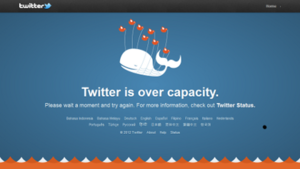<
div class=”zemanta-img” style=”margin: 1em;”>

… and back on to customer support.
Twitter has become a necessity for reputation management. Don’t want people to talk crap about you on Twitter? Use it to respond to all the naysayers and whiners! Nip those problems in the bud! Twitter is so great, you can interact directly with your customers! Hooray!
Let’s back up a minute. You know what’s great for interacting directly with your customers? Email. Over the years email based customer support tools have evolved beyond your standard POP3 mail client. I do some customer support work for NearlyFreeSpeech.Net and we have a system that makes it relatively painless.
So why are all these companies putting so much money into twitter management software like CoTweet and yet leaving their customer service departments in the last century?
The result of this Twitter madness is we’re training our customers to go there first, because it’s faster than trying to get help through the official support channel. Case in point: I was having problems with my Amazon Payments account. I sent an email to their customer support team. I was told someone would look at and respond to my request in “1-2 days.” This infuriated me more, as I was already pretty ticked off at Amazon, and so I went to Twitter to complain. Lo and behold, within a few hours of my tweet I had a response from a director at Amazon Payments.
Using Twitter to catch users who fall through the cracks is great, but it should never be a company’s first line of defense. Customer service hinges on the customer’s expectation. Exceed their expectation and you win, fall short and you lose. But the expectation varies, and isn’t always based on “rational” assumptions.
A few years ago I worked at a scooter shop in Richmond, VA. The owner had a habit of staying there late to work on things, and would often take customers’ late night phone calls to help them with their scooters. As business picked up and she had less time in the evenings, she stopped taking the late night calls. And the customers who had been calling her got mad. They had come to expect free scooter help in the middle of the night, and when the shop owner didn’t meet their expectations, they felt it was bad customer service. Never mind the fact that expecting free live scooter help at 9pm is ridiculous in the first place.
Good customer support is partially about training the customer to have rational expectations. And meeting them. Tell customers up front how long it should take to respond, and then respond in about that amount of time. If you say “1-2 days,” getting back to them on day 3 is not acceptable. On the flip side, if you say “1-2 days” but usually get back within a few hours, you’re creating the expectation that your time estimate is bogus. So if it does take you 1-2 days next time you fail, regardless of what your website says, because you already created the expectation that you’ll reply considerably faster.
Most of this is relevant to only repeat users of customer support. If you check out some customer support statistics published at NearlyFreeSpeech.Net a few years ago, you’ll see that 50% of their support requests come from 5% of their users. So while most of your users won’t interact with your support system more than once, most of your support issues will come from repeat users.
So why, why, why, why, are we training our users to go whine on Twitter? Twitter is a mediocre place to do customer support at best, and puts the user’s private information at risk in worse case scenarios. Users can’t be trusted to know when it is / is not appropriate to share information, I don’t even want to think about the amount of personal data you could scrape off Twitter from customers replying to service reps.
If you’ve got people manning the Twitter lines and yet it takes you more than a day to respond to email based customer support inquiries, you have a problem. Yes, Twitter is new and exciting, and everyone is rushing to figure out how they can control the flood of information that’s suddenly pouring from our computer screens. But you can’t play on Twitter until your homework is done, and in this case your homework is building up a good traditional customer support system.
![Reblog this post [with Zemanta]](http://img.zemanta.com/reblog_e.png?x-id=ae1c2d70-438c-4b86-8f00-4b986c2b5b54)